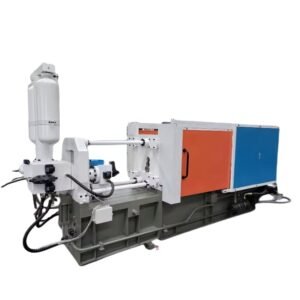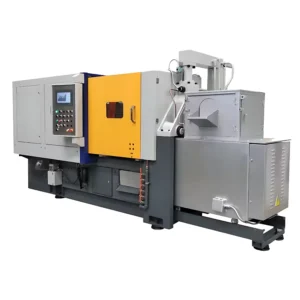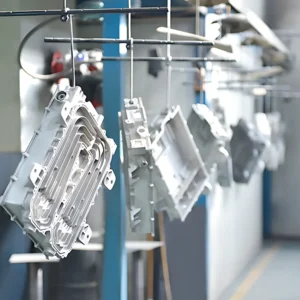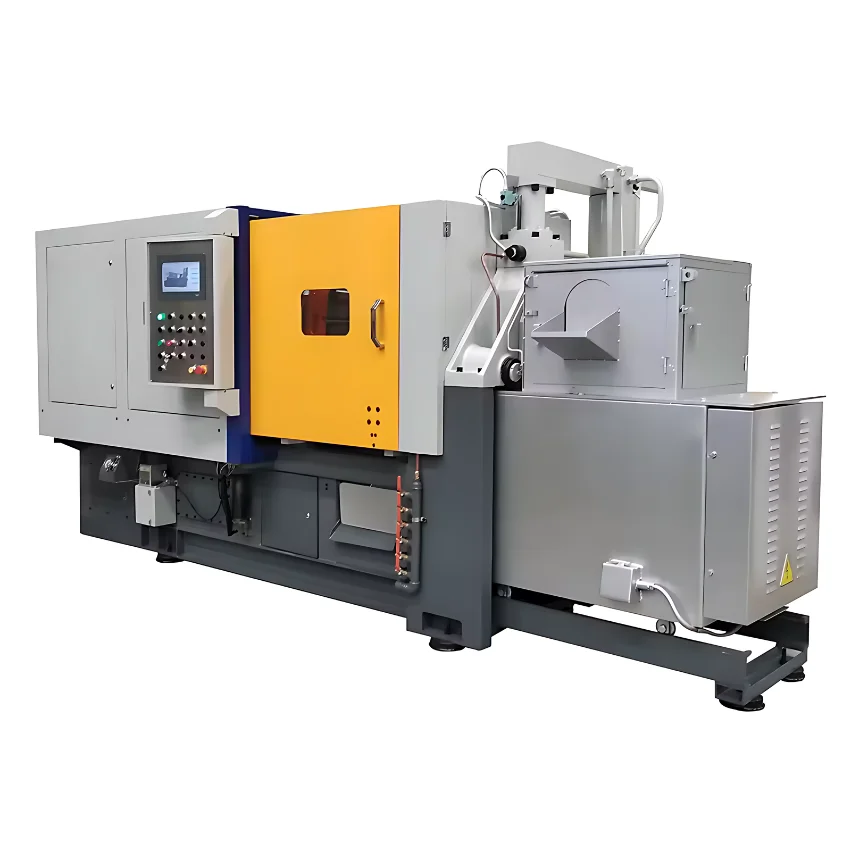Die casting uses high pressure to inject molten metal into a prefabricated metal mold and is suitable for mass production of small to medium-sized parts with precise, smooth surfaces. In contrast, sand casting uses sand to make molds, which is cheaper and suitable for producing large or small batches of complex-shaped parts, but has lower surface roughness and precision.
In this article, we’ll take you through the advantages of die casting and sand casting, compare the process differences between them, and help you decide which method is best for your project needs.
What is Die Casting?
Die casting is a highly efficient metal casting process that creates parts by injecting molten metal under high pressure into precision-machined, hardened steel molds. Widely used in product manufacturing requiring high precision and high quality surfaces, such as automotive, electronics, and consumer goods industries.
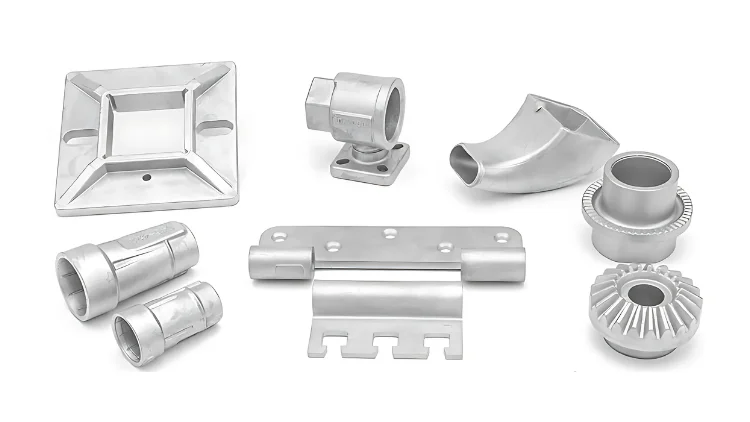
Process Step
Die casting is a precision metal casting process. The following 5 points are the steps of the die casting process:
- Mold Making: first make precision steel molds and make sure that these molds can withstand the high temperature and high pressure casting environment.
- Molten Metal: A suitable metal (e.g. aluminum, zinc, magnesium or copper) is selected and melted to a liquid state at high temperatures.
- Injection of Metal: The molten metal is rapidly injected into the mold cavity under high pressure.
- Cooling and Curing: The metal is rapidly cooled in the mold and cured into shape.
- Removing the Part: After cooling, the mold is opened to remove the molded part.
What is Sand Casting?
Sand casting is a traditional process for metal castings. During the production process, sand needs to be compacted to form the casting mold. The molten metal is then poured into the sand mold, where the metal cools and solidifies to form the casting.
Sand castings are widely used and can cast various metal parts with larger sizes and more complex shapes. They are especially suitable for the production of small and large parts.
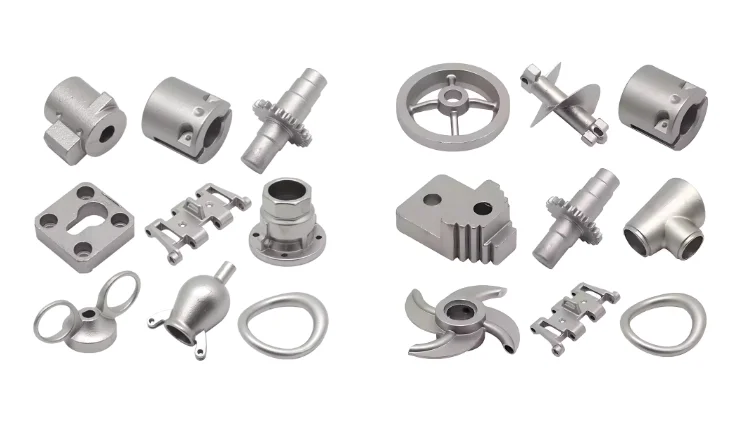
Process Step
Sand casting is a traditional metal casting process. The following 5 points are the steps of the sand casting process:
- Mold Preparation: Sand mixed with binder is packed tightly into the mold box around the model. After the sand has solidified, the model is removed, leaving the cavity.
- Pouring: Pour molten metal into the mold cavity.
- Cooling and Solidification: The metal cools and solidifies in the mold.
- Removal: After the metal solidifies, break the sand mold and remove the casting.
- Cleaning and Handling: Castings may also require removal of residual grit and may require further machining or surface treatment.
Die Casting Advantages
Here are some of the main advantages of die casting:
High Production Efficiency
Die casting can quickly produce large quantities of complex-shaped parts because the metal quickly fills the mold under high pressure and solidifies quickly, which greatly shortens the production cycle time.
Excellent Surface Quality
The surface of the die-casting parts is smooth and clean, and usually can meet the usage requirements without additional surface treatment.
Ability to Produce Complex Shapes
Die casting can produce metal parts with internal cavities, thin walls and complex shapes. Compared with other casting methods, die casting has more advantages.
Efficient Use of Materials and Energy
There is less material loss during the die-casting process, and most of the spilled or sheared metal can be remelted and reused, thereby reducing material waste and lowering production costs.
Sand Casting Advantages
Understanding the main advantages of sand casting will help you make a more reasonable choice based on different project needs. Here are some of the main advantages of sand casting:
Low Cost Mold
The molds used in sand casting are mainly made of sand, and the cost is much lower than the metal molds used by other casting methods, such as die casting.
Design Flexibility
In sand casting, the design of the mold can be easily changed, reducing the design requirements. This is especially important for product prototyping and custom parts manufacturing.
Casting Large Component Capabilities
Sand casting can be used to make very large castings, such as components for marine engines and structural parts for large machinery.
Broad Material Adaptability
Almost all casting alloys can be processed by sand casting, including iron, steel, aluminum, copper and other non-ferrous metal alloys.
Difference Between Sand Casting and Die Casting
Sand casting and die casting are two commonly used metal casting processes. There are significant differences between the two in terms of process, cost, applicability and product characteristics. Here is a comparison of the main differences between these two casting methods:
Process Flow
Sand Casting: Sand is used to compact and form a model into which molten metal is poured, the metal cools to form a casting, and finally the sand mold is broken and the casting is removed.
Die Casting: Molten metal is injected into a pre-manufactured precision metal mold using high pressure, the metal cools rapidly and solidifies, and the formed part is then removed from the mold.
Cost
Sand casting: lower tooling and mold costs make it suitable for small production runs or large parts.
Die casting: Higher initial tooling and equipment costs, suitable for mass production.
Applicability
Sand casting: This casting process has a wide range of applicability for materials and can cast a wide range of metals and alloys.
Die casting: mainly used for casting non-ferrous metals such as aluminum, zinc, magnesium and copper.
Product Characteristics
Sand casting: can cast large and complex shape parts, but the surface roughness is higher, lower precision.
Die casting: can produce a smooth surface, and accurate size of the complex shape of the parts, but is not suitable for the production if the size of the parts is too large.
The table below outlines the main differences between these two casting methods:
| Characterization | Sand Casting | Die Casting |
| Process Description | Using sand molds, the molds are destroyed after each casting | Use of metal molds, reusable |
| Cost-Effectiveness | Suitable for small-scale production, low cost | Suitable for mass production, low cost, high initial investment |
| Surface Accuracy | Rough Surface | Smooth Surface |
| Part Size and Weight | Large parts can be cast without size limitations | Typically used for casting small and medium-sized parts |
| Material Suitability | Can cast a wide range of metals and alloys | Suitable for non-ferrous metals |
| Production Speed | Slow | Fast, suitable for efficient production |
FAQ
Why is Sand Casting Preferred?
Because of its flexibility, heat resistance, and relatively low cost, sand casting is the most widely used casting process. Castings are produced by pouring liquid metal into a mold cavity. For a casting to be successful, the mold cavity must retain its shape until the metal has cooled and fully solidified.
What is Better than Sand Casting?
Permanent mold casting is a high-precision method that can produce complex parts with consistent quality and accuracy. Permanent mold has a better surface finish and lower porosity than sand casting, which eases secondary operations like machining or powder coating.
What are the Advantages of Die Casting Over Sand Casting?
While sand casting has advantages for certain applications, die casting allows for faster production rates, lower labor costs, and the ability to produce more complex shapes and thinner walls.
What is the Difference Between Sand Casting and Permanent Casting?
Permanent mold improves dimensional stability because it uses one mold to make every part. Sand casting results in more variability since every part is made with a different mold.
Summary
Choosing between die casting and sand casting depends on the specific requirements of your project, including budget, part complexity, and accuracy requirements. Die casting is suitable for large-scale manufacturing of high-quality, high-precision medium, small, and medium-sized parts. However, sand casting is more suitable for large or specially shaped parts and is more cost-effective in small-scale production.
By understanding the advantages and differences between the two casting processes above, you can make the best choice to meet your manufacturing needs. If you are looking for die casting services, contact us today to get a quote for your project.

